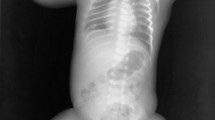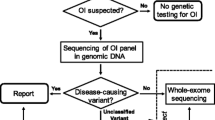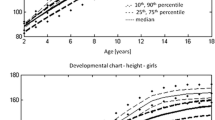Summary
One hundred twenty-seven children with osteogenesis imperfecta (O.I.) were studied during the first 10 years of life. According to Sillence, 40 patients were assigned to type I, 39 to type III, and 48 to type IV O.I. Centiles for height, weight, and the annual number of fractures could be established for the different types of O.I. The development of the skeletal changes could be documented for the different forms of the disease. At birth, the skeletal changes were significantly more severe in type III than in type IV patients. During the first 10 years of life the number of fractures, extent of skeletal deformities, and growth retardation did not differ between types III and IV. Only fracture nonunion, dentinogenesis imperfecta, and congenital cardiac malformations were more frequent in type III than in type IV. Papillary calcifications of the kidney and kidney stones were diagnosed in 4 type III and 2 type IV patients. Hemihypertrophy of the body developed, in 2 type I patients. Although types III and IV patients suffered from severe short stature, serum insulin-like growth factor (IGF) I was in the normal range.
Similar content being viewed by others
References
Byers P, Tsipouras P, Bonadia J, Starman BJ, Schwartz RC (1988) Perinatal lethal osteogenesis imperfecta (O.I. type II): a biochemically heterogenous disorder usually due to new mutations in the genes for type I collagen. Am J Hum Genet 42:237–248
Vogel BE, Minor RR, Freund M, Prockop DJ (1987) A point mutation in a type I procollagen gene converts glycine 748 of the α 1 chain to cysteine and destabilizes the triple helix in a lethal variant of osteogenesis imperfecta. J Biol Chem 262:14737–14744
Wenstrup RJ, Cohn DH, Cohen T, Byers P (1988) Arginine for glycine substitution in the triple helical domain of the products of one α2 (I) collagen allele (COL1A2) produces the osteogenesis imperfecta type IV phenotype. J Biol Chem 263:7734–7740
Sillence DO, Senn AS, Danks DM (1979) Genetic heterogeneity in osteogenesis imperfecta. J Med Gen 16:101–116
Byers P (1988) Osteogenesis imperfecta: an update. Growth, Genet Horm 4:1–5
Thompson EM, Young ID, Hall CM, Pembrey ME (1987) Recurrence risk and prognosis in severe sporadic osteogenesis imperfecta. J Med Gen 24:390–405
Viljoen D, Pearn J, Beighton P (1984) Manifestations and natural history of idiopathic hemihypertrophy: a review of eleven cases. Clin Gen 26:81–86
Smith R, Francis MJO, Houghton GR (1983) The brittle bone syndrome. Butterworth, London
Tanner JM, Whitehouse RH (1976) Clinical longitudinal standards for height, height velocity, weight velocity and stages of puberty. Arch Dis Child 51:170–177
Smith R, Francis MJO, Bauze RJ (1975) Osteogenesis imperfecta. A clinical and biochemical study of a generalized connective tissue disorder. Quart J Med 176:555–573
Paterson CR, McAllion S, Miller R (1983) Osteogenesis imperfecta with dominant inheritance and normal sclerae. J Bone Joint Surg 65B:3935–3938
Paterson CR, McAllion S, Shaw JW (1987) Clinical and radiological features of osteogenesis imperfecta type IV. Acta Paediatr Scand 76:548–552
Wynne-Davies R, Gromley J (1981) Clinical and genetic patterns in osteogenesis imperfecta. J Bone Jt Surg 63B:287–298
Sillence DO, Barlow KK, Cole G, Dietrich S, Gerber AP, Rimoin DL (1986) Osteogenesis imperfecta type III. Delineation of phenotype with reference to genetic heterogeneity. Am J Med Genet 23:821–832
Burke TE, Crerand SJ, Dowling F (1988) Hypertrophic callus formation leading to high-output cardiac failure in a patient with osteogenesis imperfecta. J Pediatr Orthop 8:605–610
Beals RK (1982) Hemihypertrophy and hemihypotrophy. Clin Orth Rel Res 166:199–203
Lukinmaa PL, Ranta H, Ranta K (1987) Dental findings in osteogenesis imperfecta: occurrence and expression of type I dentinogenesis imperfecta. J Craniofac Genet Dev Biol 7:115–125
Hortop J, Tsipouras P, Hanley JA, Marcon BJ, Shapiro JR (1986) Cardiovascular involvement in osteogenesis imperfecta. Circulation 73:54–60
Rudolf AM (1974) Congenital diseases of the heart. Year Book Medical Publishers, Chicago
Vetter U, Maierhofer R, Mueller M, Lang D, Teller WM, Brenner R, Frohneberg D, Woersdoerfer O (1989) Osteogenesis imperfecta in childhood: cardiac and renal manifestations. Eur J Pediatr 149:184–187
Underwood LE, Clemmons DR, D'Ercole AJ, Minuto F, Chatelain PG, Copeland KC, van Wyk JJ (1982) Somatomedin C: measurement by radioimmunoassay and regulatory mechanisms in human subjects. Bull Swiss Acad Med 183:100–110
Binoux M, Gourmelen M, Girard F (1986) Serum levels of insulin-like growth factor and IGF binding protein in constitutionally short children and adolescents. Acta Endocrinol 113:145–152
Author information
Authors and Affiliations
Rights and permissions
About this article
Cite this article
Vetter, U., Pontz, B., Zauner, E. et al. Osteogenesis imperfecta: A clinical study of the first ten years of life. Calcif Tissue Int 50, 36–41 (1992). https://doi.org/10.1007/BF00297295
Received:
Revised:
Issue Date:
DOI: https://doi.org/10.1007/BF00297295




